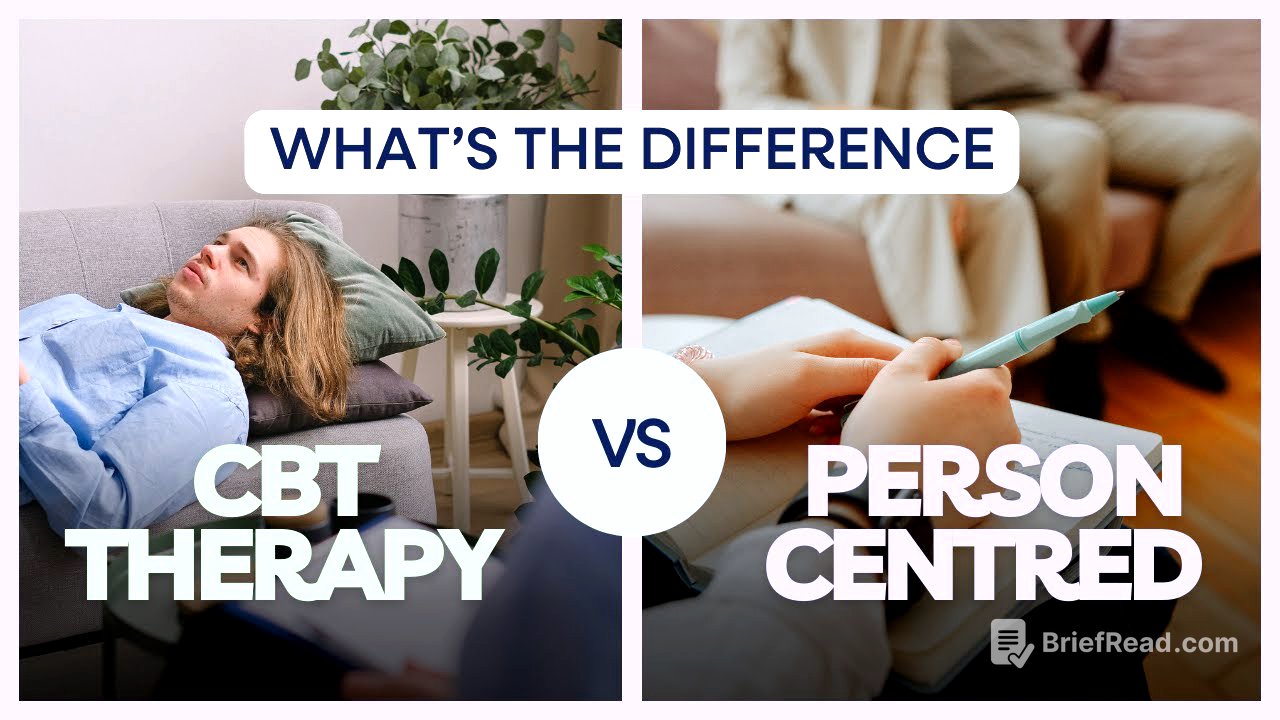TLDR;
This video provides an overview of Cognitive Behavioral Therapy (CBT) and Person-Centered Therapy, highlighting their core principles, techniques, and key differences. CBT focuses on changing negative thought patterns and behaviors through structured sessions and homework, while Person-Centered Therapy emphasizes empathy, unconditional positive regard, and client-led exploration for personal growth. The video also discusses the roles of therapists in each approach, the typical duration of therapy, and the objectives, helping viewers understand which therapy might be more suitable for their needs.
- CBT is structured and goal-oriented, focusing on changing negative thoughts and behaviors.
- Person-Centered Therapy is flexible and client-led, emphasizing empathy and personal growth.
- Therapists play different roles: directive in CBT, supportive in Person-Centered Therapy.
- CBT is typically short-term, while Person-Centered Therapy can be longer-term.
Introduction [0:00]
The video introduces two therapeutic approaches: Cognitive Behavioral Therapy (CBT) and Person-Centered Therapy. Both therapies are effective but differ significantly in their philosophies and techniques. The video aims to explore these differences to help viewers understand each approach better.
CBT Therapy Overview [0:27]
Cognitive Behavioral Therapy (CBT) is a structured and time-limited therapy that focuses on the relationship between thoughts, feelings, and behaviors. The core idea is that changing negative thinking patterns can positively influence emotions and improve mental well-being. CBT therapists work with clients to identify and modify maladaptive thoughts and cognitive distortions, fostering healthier thinking patterns. Homework assignments are a significant component, encouraging clients to apply learned exercises in their daily lives. For example, a CBT therapist might help a client with anxiety identify and replace catastrophic thoughts with more balanced perspectives, reducing anxiety and related behaviors like nail-biting or restlessness.
Person-Centred Overview [1:41]
Person-Centered Therapy, developed by Carl Rogers, centers on creating an empathetic and open space for clients to share their thoughts and feelings without judgment. In this approach, the therapist adopts a non-directive role, refraining from leading the conversation and instead maintaining unconditional positive regard, strong listening, and understanding. The goal is to help clients access their own resources and self-awareness, facilitating personal growth and self-discovery. For instance, a therapist might provide a space of empathy and unconditional positive regard for a client struggling with low self-esteem, helping them unpack their feelings in a safe environment.
Key Differences [2:47]
CBT is highly structured, with therapists and clients following a set agenda to achieve specific goals within a limited number of sessions (5-20). Person-Centered Therapy is more flexible, allowing the conversation to flow naturally based on the client's needs, leading to a more organic exploration of feelings over a potentially longer period. CBT emphasizes changing negative thinking patterns and behaviors to address specific issues like anxiety or depression, often using techniques like cognitive restructuring and behavioral experiments. Person-Centered Therapy focuses on emotional exploration and personal growth, emphasizing understanding the client's thoughts, feelings, and behaviors to facilitate self-discovery and the client's inherent ability to heal and grow. In CBT, the therapist is more directive, guiding the client with specific techniques and homework, acting as a coach to apply strategies in real-life scenarios. In Person-Centered Therapy, the therapist is a supportive listener, fostering a safe and open environment with empathy and authenticity, allowing the client to explore their feelings without fear or judgment. CBT is typically short-term, aiming to achieve set goals quickly, such as completing therapy for anxiety within 12 sessions. Person-Centered Therapy can be longer-term, depending on the client's evolving needs and pace, with some clients exploring their feelings slowly over months or years. CBT is goal-oriented, with clear objectives set at the beginning and measurable outcomes regularly assessed to track progress. If someone is dealing with deeper emotional issues or wants to facilitate personal growth, Person-Centered Therapy might be more suitable, offering a supportive space.









